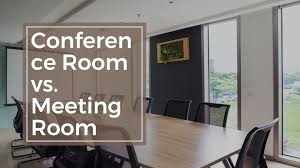Conference rooms typically provide a large conference table where people can hold centralized discussions, while meeting rooms typically include a small round table surrounded by comfortable chairs. The setup of either room depends on the size, function, and equipment that are need for meetings and engagements. Here are some distinctions between a conference room and a meeting room:
What Is a Conference Room?
A conference room is ideal for extended comfort and enhanced presentations, often providing a projector, screen, and comfortable seating suitable for larger executive conference meetings. Other features commonly found in a conference room include an AV system, glass walls, a whiteboard for visual collaboration, and toose designed for multimedia integration. If you book this type of room, you can expect it to come with a video conferencing setup.
Most rooms have multiple power outlets, dim lighting options, and executive chairs. It’s usually easy to control the climate in a conference room. Workspaces that provide these rooms usually make sure that the rooms have acoustic insulation and designated food areas. The room might also have conference software, a scheduling system, and partition walls. You are likely to find wall-mounted speakers and multiple monitors in a conference center.
What Is a Meeting Room?
Meeting rooms typically have minimal technology, such as a flip chart, adjustable lighting, and a chalkboard, although most provide high-speed WiFi. Other things you can expect in a meeting room include a handheld remote and a portable projector to provide flexible presentation and easy device control. Some meeting rooms provide window blinds to easily control the light and a digital board for those who want to have interactive presentations. They also typically have multiple monitors and adjustable seating arrangements with versatile configurations. While the atmosphere in a meeting room is relaxed, the room might include professional décor to create an some ambiance suitable for business functions.
What Are the Primary Functions of a Conference Room?
Conference rooms are ideal for business presentations and team discussions. They allow you to have a professional delivery and do your planning in their focused atmosphere. If you want to hold a board meeting, host an annual review, or pitch your ideas to a client, choose conference space. Other activities that can take place in a this type of room include training sessions, virtual meetings, and strategy workshops.
The conference center is also ideal for keynote speeches and leadership summits because it provides an atmosphere for focused attention. Your HR team can use the room to conduct hiring interviews and evaluate candidates. This is the right place if your company plans to conduct performance reviews. Other activities that that can take place in a conference room include vendor negotiations, industry panels, and customer briefings.
What Are the Primary Functions of a Meeting Room?
The compact nature of a meeting room makes it ideal to host brainstorming sessions and do collaborative planning. If you want informal discussions with open exchanges, a meeting room is right for you. A meeting room could be a good place to do project kickoffs and weekly updates for your team. A small team can do it in a meeting room when they want to have a focused discussion.
Team building activities, proposal brainstorming, and process evaluation can occur in a meeting room. A meeting room is small enough to hold an a training session. This type of room is useful when you need to provide quick updates in a standup meeting. You can also do creative exercises and the documentation review inside a meeting room. If there is a new staff member, they can do introductions to other team members inside a meeting room. You can also do follow-up reviews, boarding sessions, and mentorship meetings.
Book a Room for Your Business Needs
Depending on your needs, a meeting room might be enough, or you may need to uprgrade to a conference room with additional amenities. Executive functions call for larger meeting rooms with more features. Contact a workspace that provides these types of meeting rooms to get started.
